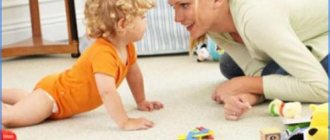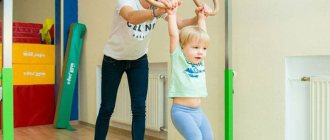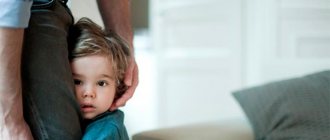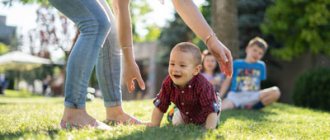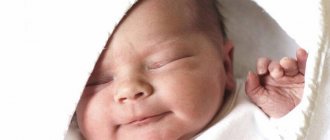The first year of a child’s life is accompanied by intensive development. When a baby is born, he can only scream; by the full 12 months, he begins to develop character traits.
In one year, personality begins to form
Before inviting guests who just this morning wrote congratulations to the parents on the first year of their baby, you need to understand: this is a very important period, so you need to be able to properly care for a child of this age.
What should a 1 year old child be able to do?
The process of child development is a purely individual phenomenon, and even recently it has been going somewhat slower than 10-20 years ago. The norms are established only statistically, so there are many children who mature later than the described periods. In general, at 1 year of age a child can:
- Stand holding onto support;
- Sit;
- Repeat simple actions after parents;
- Take the first steps;
- Build towers, small pyramids;
- Scoop up water;
- Rub objects.
The baby is crying
Important! One-year-old children usually explore the world by feeling the objects around them.
Development norms
How to choose shoes for a child under 1 year old
On average, by the year the growth rate is 1.5 centimeters per month. After 12 months the pace slows down. The rate of weight gain at this age is 350 grams per month. The approximate height of a one-year-old baby is 72-77 centimeters, and weight is 10-11 kg.
For boys
According to domestic pediatricians, boys' height ranges from 72.3 to 79.7 centimeters, and their weight ranges from 8.9 to 11.6 kilograms. Normal head circumference is 45.3-48.6, chest circumference is 46.1-52.5. According to WHO, these values fluctuate in a slightly larger range.
For girls
Height varies from 71.4 centimeters to 78 cm, weight - from 8.5 to 10.8 cm. Head circumference - 44.2-47.3 cm, chest - 46.3-51.4 cm.
Mental development
The mental development of a child at 1 year is reflected in the first age crisis. This is due to the fact that the baby begins to realize that he and his mother are two completely different creatures, which only intensifies his desire to understand the world around him and become independent.
When trying to master any skill, the baby will naturally make mistakes, but the help of adults can provoke attacks of irritability and even hysterics. This happens because the baby can categorically reject ideas if they do not come from him. And parents sometimes need to show all their patience in order to help their child calm down.
It is extremely important for children at this age to know that, despite mistakes and whims, they are accepted for who they are. They become affectionate and often run up to their parents, expecting them to hug them, reassure them, help them reach an object of interest, quench their thirst or hunger, change a diaper, or simply indicate their presence.
What can parents do for the psychological development of a child at 1 year old? You must try to follow the rules:
- Don't distance yourself from your baby, even if you have important things to do. By participating in the daily events of the family, the child learns about how this world works. You are a model for him. Your actions let him know that the world around him is reliable, safe, and can be safely explored on his own.
- Respond to the child’s call; it is important for him to know that his person is valuable to you. However, you don’t have to do this right away. Sometimes it is enough to say: “Now I will solve my problem and will definitely help you.”
What does a one year old baby look like?
Baby is 1 month old
A one-year-old baby is already much less like a baby; his proportions are more reminiscent of a child’s.
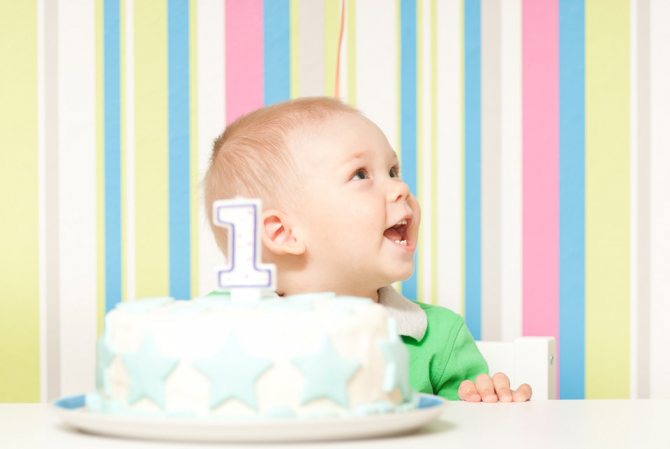
Baby celebrates first birthday
Physical characteristics of a child at 12 months
Despite the fact that the rate of growth and weight is slowing down, the appearance of a one-year-old child is still actively changing. The baby becomes more alert, so most of the energy is not stored in fat, but burned. A twelve-month-old baby's teeth appear. Their number ranges from 6 to 12 or even more. Your gums may hurt as your teeth grow. This process is sometimes accompanied by temperature. Also, the baby often drools profusely. This is the norm.
Attention! Although the baby is already able to confidently lie on his stomach and crawl on his own, it is important to understand that each child is individual.
Boys are traditionally larger on average than girls. But a particular baby may be larger and heavier than a baby of a similar age. This should not be a cause for concern. The child's muscles are now strong enough to be able to stand with support and climb stairs with the help of a parent. One-year-old children love to climb peaks, so you need to take care of their safety. You should not leave windows open in rooms where the baby is without parental supervision; it is better to keep the baby away from sockets, wires and other dangerous objects.
Psychological development of a child at 12 months
The formation of the personality of a one-year-old child occurs at an active pace. At this age, the baby can already:
- Open and close doors and drawers in cabinets.
- Put things in a box.
- Throw balls and roll them on the floor.
At this age, the baby actively imitates the actions of an adult, although at times he may not obey him. One-year-olds continue to put things in their mouths to get a taste of things.
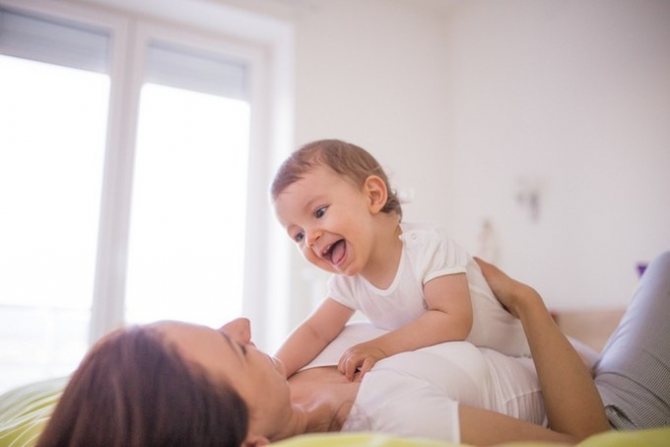
One year old baby communicates
At this age, the speech and emotional spheres actively develop. The child may laugh, get scared, cry. Facial expressions are also formed. Children are able to meaningfully speak simple words consisting of two identical syllables (mom, dad, kaka, baba and others). The child understands quite well the intonation of adults and some of the words they pronounce. The baby learns to moo even earlier, but by this age the intonations acquire a specific semantic connotation.
Important! The child develops his first self-care skills. He learns to eat on his own, drink from a cup, and undress. When appropriate, efforts to do so should be encouraged.
When a child turns 1 year old, a crisis occurs. It is expressed in the first attempts to separate from parents. At times, the baby behaves quite stubbornly until he receives the right amount of attention. At the same time, the child reacts strongly emotionally to adults’ comments.
At 12 months, the following age-related neoplasms appear, describing why the one-year crisis occurs:
- Walking. When a child is 1 year old, he learns to walk. This opens up new possibilities for the baby, since he can pick up the necessary thing and perform any actions with it. Objects used by adults become especially attractive to babies. But some of them can be dangerous, so parents prohibit using them. For a baby, such warnings are a command to do the opposite. The child learns to understand his desires and achieve goals.
- Autonomous speech. The baby slowly moves from babbling to real linguistic structures. But until a child has learned to speak like an adult, he is often not understood. This causes a negative emotional reaction in a baby who is one year old.
- Motivating performances. When a baby is one year old, he gains the ability to form images in his imagination and act in accordance with them. L. I. Bozhovich calls them motivating ideas. The baby becomes less dependent on immediate stimuli. When the baby turns one year old, it is much more difficult to distract the child with some object, since the child will act in accordance with his target constructs.
- Self-image. From the second half of life, the ability to perceive one’s actions as the cause of the results obtained appears, and this is how the self-image is formed. The baby begins to recognize himself in the mirror. For example, if you put a bandage on the forehead of a one-year-old boy or girl and show the child his reflection, the baby can note this and try to remove what the child thinks is a negative object. That is, the baby is able to perform actions aimed at himself. The same behavior also manifests itself when communicating with adults. The child tries to copy the actions of other people at this age.
Important! A child may be at risk for autism if he or she has difficulty imitating gestures (such as pats), avoids eye contact, and does not respond when an adult appears.
Baby's hearing and vision at 12 months
By 12 months, hearing and vision should have passed the last stage of development. Already at the end of the ninth month, the baby sees almost the same as adults. At one year of age, he is attracted to bright and contrasting colors. The baby can determine the distance to an object, is able to distinguish close objects from distant ones, and recognizes familiar faces.
At the same time, his ability to coordinate vision and muscle function is not yet sufficiently developed. He may not understand where to place his arm or leg, and because of this he may look quite ridiculous. This will pass with time.
Features of physiology
Approximate figures for age 1 year 11 months are as follows:
- for boys, height 84-90 cm, weight 11-13.5 kg, head circumference 47-49 cm;
- for girls height 82-89 cm, weight 10-13 kg, head circumference 45.5-48 cm.
Becoming more dexterous and skillful, the baby consolidates the previously acquired development and also acquires new skills:
- not only throws the ball, but now catches it with his hands,
- confidently jumps on two legs, and also masters jumping on each leg separately,
- runs in different directions without problems, adds the ability to move backwards to his skills,
- actively dances to the music, repeats movements, squats, sways to the beat from side to side.
Many parents note that at the age of 1 year 1 month, it became common for a child to reduce independent motor activity and crawl into his arms. In response to such concerns, psychologists advise communicating more with your children and paying attention to them, since such behavior is nothing more than a child’s protest against coercion and independence. The child wants to be pitied and supported more often, so he climbs into his arms in search of protection.
Experts advise in cases of protest to seek a compromise and alternate between briefly holding hands (for example, when sitting on the sofa while reading books) and moving independently (for example, holding a hand while moving to the bathroom for evening dressing).
By the age of 1 year 11 months, almost every child is confident in using the potty; only a few still do not control their physiological needs in the toilet.
See also:
Features of child development at 8 months Child development calendar
Features of child development at 1 year 3 months Child development calendar
Features of child development at 1 year and 9 months Child development calendar
As a rule, by this age it becomes clear which hand is dominant and whether the baby is left-handed or right-handed.
Psychologists advise not to retrain a child if he actively uses only his left hand.
Educational games for 12 months
3 months baby
When a baby turns one year old, he needs to actively play with him. Entertainment should be selected so that he develops his skills. In the process, it is necessary to build a trusting relationship with the baby. Games should be aimed at exploring the world around us, training movement coordination and improving speech skills. The following exercises worked well:
- Repeat. The game is aimed at developing baby talk. The baby’s task is to pronounce syllables spoken by an adult or by himself. To get a response from the child, you need to repeat them several times.
- Hide and seek. The game is capable of developing spatial perception and memory. The parent hides behind a chair or closet, then looks out and calls the baby. After some time, the baby begins to repeat after the adult. Then the game needs to be complicated - just call the baby. This allows you to increase your ability to navigate by sound.
- Dancing. Any musical games develop a sense of rhythm. You can play the melody on your computer or buy toys. The parent shows the baby what to do, and he tries to dance to the music. Melodies can be alternated, replacing cheerful compositions with calm ones. At the same time, its pace should not be too fast so that the child has time to keep up with the rhythm.
- You can try spinning.
Children's books and toys
1 year - it's time to pay money, buy and give a book to a one-year-old. This is how a love of reading is formed. Thematically, the literature is selected so that the child finds it interesting. The main criterion at this age is a large number of bright color pictures. The baby can mock the first books in every possible way: put them in his mouth, gnaw, bite, tear. Therefore, it is important not to buy too expensive copies.
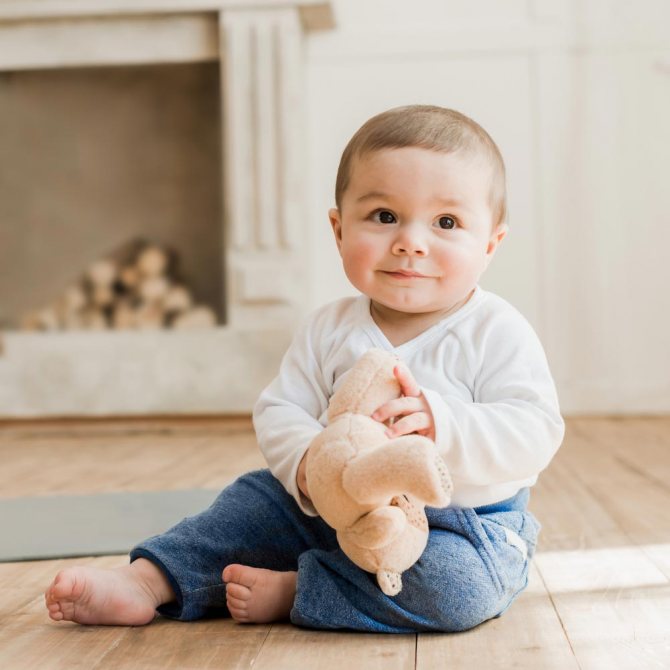
One year old cutie
Toys can also develop a child. For example, a baby often likes the following items:
- Ball.
- Pyramid. This toy is a unique invention. It trains fine motor skills, intelligence, the ability to distinguish colors, and perseverance. Nowadays, a large number of types of pyramids have been created, including unique ones, capable of making sounds, and having different bizarre shapes.
- Cubes.
- Wheeled car.
At this age, it is important not to let children play with small objects. All kinds of construction sets and puzzles need to be hidden from the eyes of the little ones.
Nutrition and sleep
At the age of one year, the baby hardly eats breast milk or formula. Typically feeding occurs in the early morning and late dinner. All other meals are an adult diet, adapted for a child. Stores also sell ready-made food adapted to the body characteristics of a one-year-old child.
The composition of such products is different: meat and vegetable purees, children's cookies and others. The number of meals is the same as for adults: breakfast, morning snack (if necessary), lunch, afternoon snack and dinner.
A one-year-old child's sleep duration is usually about 14 hours. At night the baby sleeps for about 12 hours, the duration of daytime sleep is two hours. The waking time depends entirely on the individual needs of the baby’s body at one year of age.
Thus, 1 year is the period when a little person ceases to be a baby and enters a new period of his life.
Care and daily routine of a 1-year-old child: sleep, wakefulness, feeding, walks
Upon reaching one year of age, the child’s routine gradually changes. Remember that, despite all his activity, he is not yet strong enough, so fatigue sets in quite quickly.
Fresh air should be regularly circulated in his room. During the cool season, the bedroom should be ventilated several times. Regardless of the time of year, the baby needs to go for a walk every day, for at least two hours. Don't just push him around in a stroller; he should go for walks periodically.
In the first six months, he ate exclusively formula milk or breast milk, but by the year his diet should be significantly diversified with milk porridges, fruit and vegetable purees, steamed cutlets, cookies, stewed vegetables, cottage cheese and other things.
At this time, the child’s first teeth appear and he learns to chew food. This is not a sign that he is ready to completely switch to “adult” food. For now, he has to prepare food separately from the rest of the family. Serve baby food grated or finely chopped.
What foods is it time to introduce a one-year-old toddler to: chicken or quail eggs, buckwheat and oatmeal, pasta, potatoes, raw and boiled vegetables, milk soups, boiled meat, butter, bread, cookies. Add chopped herbs to some dishes - parsley, dill, green onions.
At one year of age, a child is prohibited from offering fried foods - only boiled or steamed foods are suitable for him. Be sure to wipe hard vegetables and fruits, such as apples and carrots. It is permissible to simply cut melon, watermelon, and banana into small cubes. It is advisable to serve plums, cherries, and apricots in boiled form - puree, compote.
While the baby's stomach is very small, the baby has plenty of energy, so frequent feeding in small portions is necessary. He should eat five times a day: breakfast, lunch, afternoon snack, dinner, and at night, cookies with kefir or other simple food. By the age of one and a half years, it will be possible to switch to four meals a day, eliminating meals before bedtime. Does your child have a poor appetite? Beautifully presented food, bright plates, interesting napkins and other aspects that attract attention can help.
A one-year-old toddler needs to sleep approximately 13-14 hours a day. For a night's sleep, about 11-12 hours is enough. During the day, sleep duration is about 2-3 hours. The individual needs of the child's body determine the time of wakefulness. About 4 hours of wakefulness is often enough, but some babies don't want to sleep much longer.
Many children want to sleep only once a year, but not everyone can withstand such a rhythm. It is much more comfortable for one-year-old children to sleep twice a day for about an hour and a half. The second dream may be shorter. For children who sleep 12 hours or more at night, one daytime nap is suitable, the duration of which should be at least 2 hours. Try to adhere to the regime - 11-12 hours of night sleep provide the necessary energy, sufficient for active psychological and physical development.




